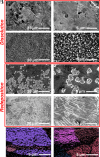On the hidden transient interphase in metal anodes: Dynamic precipitation controls electrochemical interfaces in batteries
- PMID: 40203045
- PMCID: PMC12012512
- DOI: 10.1073/pnas.2425752122
On the hidden transient interphase in metal anodes: Dynamic precipitation controls electrochemical interfaces in batteries
Abstract
The solid-electrolyte interphase (SEI) formed on a battery electrode has been a central area of research for decades. This structurally complex layer profoundly impacts the electrochemical deposition morphology and stability of metal anodes. Departing from conventional approaches, we investigate metal dissolution-the reverse reaction of deposition-in battery environments using a state-of-the-art electroanalytical system combining a rotating-disk electrode and operando visualization. Our key finding is the presence of a transient SEI (T-SEI) that forms during fast discharging at high dissolution rates. We attribute T-SEI formation to local supersaturation and resultant electrolyte salt deposition. The T-SEI fundamentally alters the dissolution kinetics at the electrochemical interface, yielding a flat, clean surface. Unlike a classical SEI formed due to electrolyte decomposition, the T-SEI is "relaxable" upon removal of the enforced dissolution current; that is, the T-SEI dissolves back into the electrolyte when rested. The formation of T-SEI plays an unexpected critical role in the subsequent electrodeposition. When the metal is redeposited on a fully relaxed T-SEI surface, the morphology is remarkably different from that deposited on pristine or low-rate-discharged metal electrodes. Electron backscatter diffraction analysis suggests that the deposition occurs via growth of the original grains; this is in stark contrast to the isolated, new nuclei seen on standard metal electrodes without T-SEI formation. Using 3D profilometry, we observe a 42% reduction in surface roughness due to T-SEI formation. Our findings provide important insights into the kinetics at ion-producing electrochemical interfaces, and suggest a new dimension for engineering next generation batteries.
Keywords: batteries; interphase; metal anodes.
Conflict of interest statement
Competing interests statement:The authors declare no competing interest.
Figures






References
-
- Roberts M., On batteries. J. Soc. Telegraph Eng. 6, 257–273 (1877).
-
- Li Q., Chen A., Wang D., Pei Z., Zhi C., “Soft shorts” hidden in zinc metal anode research. Joule 6, 273–279 (2022).
-
- Lin D., Liu Y., Cui Y., Reviving the lithium metal anode for high-energy batteries. Nat. Nanotechnol. 12, 194–206 (2017). - PubMed
-
- Geng X., Hou X., He X., Fan H. J., Challenges and strategies on interphasial regulation for aqueous rechargeable batteries. Adv. Energy Mater. 14, 2304094 (2024).
Grants and funding
LinkOut - more resources
Full Text Sources

